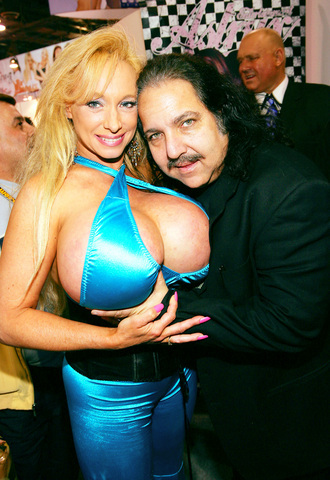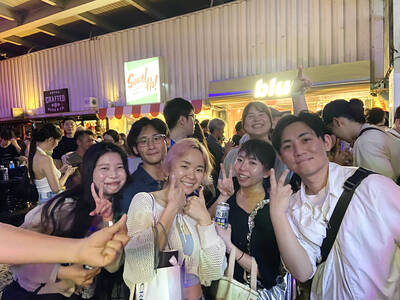Technosexuals -- - the freakish gadget dandies who like their technology as sexy as they are -- were in virtual heaven over the weekend in Las Vegas as the annual Consumer Electronics Show coincided with the porn industry's annual awards bash.
The term technosexuals was invented last year as a backlash to the conventional image of technology geeks as unwashed, uncool men with pizza crumbs stuck in their beards. But it also connotes the growing focus in the technology industry on making products for fashionable lifestyles -- from tiny pink cellphones equipped with MP3 players and digital cameras, to sleek red laptops designed to complement the little red Ferrari in the driveway.

PHOTO: DPA
Paradoxically, as the staid stable of tech companies were trying to get sexy, the sexy world of the Adult Entertainment Expo was going more mainstream. Respectable Columbia House, which dominates the book, music and DVD subscription clubs, was at the steamy expo preparing to launch a similar club for connoisseurs of porn.

PHOTO: DPA
The porn stars were out on the town more than they were at the packed convention center, mingling in surreal fashion with tech industry insiders.
There was hardly a bar in Vegas that did not feature provocative women with large silicon implants wearing skimpy clothes that seem to be shrinking even faster than the world's average gadget size.
And despite a US$45 (NT$1,450 entrance fee, there was no shortage of CES visitors who somehow found the time to line up for more than an hour to get into the sex-fest, where huge flat panel screens displayed an endless stream of naked flesh and stall after stall proudly displayed the latest and greatest sex toys.
The exhibitors at the CES -- which is regarded as the world's largest gadget show -- were trying their best not to be left behind.
From huge, high definition televisions to tiny handheld gadgets that can communicate wirelessly, play games and movies and do almost everything but the laundry, there were gadgets for every lifestyle.
Even mundane household chores did not escape the world's inventors. On show were ovens, washing machines and other domestic appliances that could all be controlled from your computer's browser.
But the best gadgets were those that were no longer in the experimental stage but ready to take center stage in our evolving digital lives, where for better or for worse our information will be with us wherever we go -- keeping us connected around the clock via the great oracle that is the network.
The Dell Axim x50v is the first Pocket PC with a VGA screen and boasts more power than many desktop computers could boast just a few years ago.
"Like many products at the show, this Axim shows how the evolution of consumer electronics products is enabling all sorts of new applications" said Michael Miller, editor in chief of PC Magazine.
Other mobile gadgets that earned plaudits were the PalmOne Treo 650, the latest version of the cellphone hybrid, which offers PDA functions, wireless e-mail and phone service in a single device. The XM2Go was another miniature marvel: a handheld receiver for satellite radio.
But the mini-device that earned the most attention -- and will probably have the largest sales -- was Sony's new PSP, a handheld gaming machine that the ailing Japanese giant hopes will help it capture the sector from Nintendo's GameBoy line.
Alongside mobile devices, the other great focus of the technology show was on digital home-entertainment products.
The king of televisions was without question Samsung's 2.6m-wide, high-definition LCD screen -- a monster so large, bright and clear that it is sure to make even cinema-owners jealous when it goes on sale.
Almost every computer maker was also showing off media hubs that transform regular computers into virtual juke-boxes, able to wirelessly stream pictures, videos and music to any connected device, including -- for the rich and lucky -- Samsung's magnificent beast.
Unlike previous shows, which overhyped an imminent immersion into the converged digital lifestyle, this year's products are relevant now.
The concurrent advances in broadband, wireless connectivity and LCD technology, combined with the miniaturization of processing chips and storage devices, mean that the world is really on the verge of a new technological future, where information and entertainment will be immediate and ubiquitous.
This is the Holy Grail that the tech industry has been promising since the birth of the Internet, and its realization should fuel the profits of consumer technology providers for years to come.
According to the Consumer Electronics Association, 2004 sales in the US grew 11 percent to US$113.5 billion. CEA projections are that shipments will rise to US$125.7 billion this year, followed by a multi-year global growth rate for the coming decade of close to 15 percent.
If those numbers hold true, we will all be technosexuals.

Late last month Philippines Foreign Affairs Secretary Theresa Lazaro told the Philippine Senate that the nation has sufficient funds to evacuate the nearly 170,000 Filipino residents in Taiwan, 84 percent of whom are migrant workers, in the event of war. Agencies have been exploring evacuation scenarios since early this year, she said. She also observed that since the Philippines has only limited ships, the government is consulting security agencies for alternatives. Filipinos are a distant third in overall migrant worker population. Indonesia has over 248,000 workers, followed by roughly 240,000 Vietnamese. It should be noted that there are another 170,000

Hannah Liao (廖宸萱) recalls the harassment she experienced on dating apps, an experience that left her frightened and disgusted. “I’ve tried some voice-based dating apps,” the 30-year-old says. “Right away, some guys would say things like, ‘Wanna talk dirty?’ or ‘Wanna suck my d**k?’” she says. Liao’s story is not unique. Ministry of Health and Welfare statistics show a more than 50 percent rise in sexual assault cases related to online encounters over the past five years. In 2023 alone, women comprised 7,698 of the 9,413 reported victims. Faced with a dating landscape that can feel more predatory than promising, many in

“This is one of those rare bits of TikTok fitness advice with a lot of truth behind it,” says Bethan Crouse, performance nutritionist at Loughborough University. “Sometimes it’s taken a bit too literally, though! You see people chugging protein drinks as they’re scanning out of their gym.” Crouse recommends the athletes she works with consume 20-30g of protein within 30-60 minutes of finishing a resistance training session. “The act of exercising our muscles increases the breakdown of muscle proteins,” she says. “In order to restore, or hopefully improve them — and get gains such as increased muscle mass or strength —

“Far from being a rock or island … it turns out that the best metaphor to describe the human body is ‘sponge.’ We’re permeable,” write Rick Smith and Bruce Lourie in their book Slow Death By Rubber Duck: The Secret Danger of Everyday Things. While the permeability of our cells is key to being alive, it also means we absorb more potentially harmful substances than we realize. Studies have found a number of chemical residues in human breast milk, urine and water systems. Many of them are endocrine disruptors, which can interfere with the body’s natural hormones. “They can mimic, block